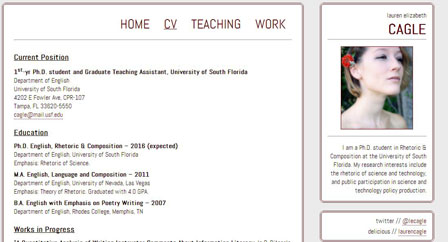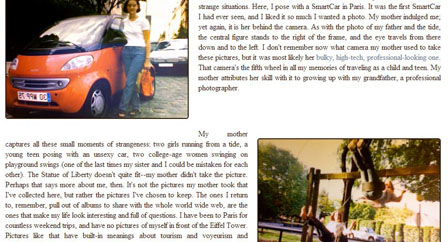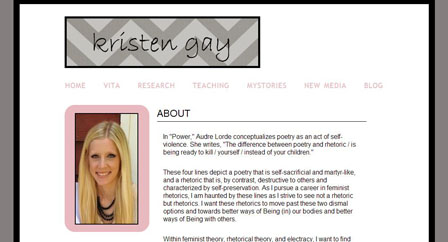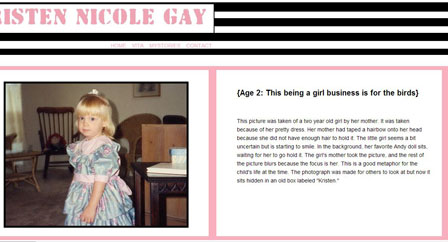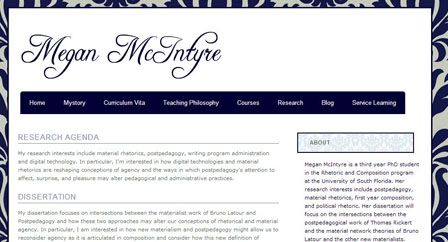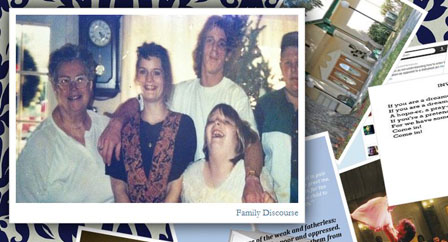Our [Electrate] Stories
Explicating Ulmer's Mystory Genre
Marc C. Santos, Ella R. Bieze, Lauren E. Cagle, Jason C., Zachary P. Dixon, Kristen N. Gay, Sarah Beth Hopton, Megan M. McIntyre
5. Should a mystory be public or private?
We want to begin by suggesting that the question of public vs. private actually represents a continuum of public-ness and private-ness as opposed to a binary of distinct choices. It raises a number of questions concerning affect, professionalism, and identity:
- What is the purpose of the mystory as it relates to establishing a particular digital identity?
- What are the risks associated with performing this project in a public/professional space?
- What is the relationship between the professional and private selves as performed in the mystory?
- To whom does the mystory belong?
- What are the ethics of telling mystories when those stories implicate others?
Answers to these questions vary according to what each participant believed to be the purpose of the mystory. As Lauren E. Cagle noted, “Whether or not a mystory should be public or private is a troubling question. It leads us to reassess our first question: ‘what work does the mystory do?’” For those who saw the mystory as a way of building electrate relationships, a social project meant to establish connections with the larger web community, the mystory had to be public. Zachary P. Dixon argued that the mystory is “designed to be a public expression” and explains that the “purpose of Ulmer’s overarching EmerAgency project, of which the mystory forms a critical part, is to change the world.” Similarly, Sarah Beth Hopton positioned the public mystory as a “contact zone” (Pratt, 1991). Both Dixon and Hopton, then, champion the mystory as a public document.
On the other hand, Kristen N. Gay argued that the mystory is a personal, private endeavor designed to prepare the self for civic action. As we noted in question 1, Gay positioned the mystory as preparing “us for ethical interaction [which] springs from valuing personal, embodied, and subjective experiences as the starting point for understanding ourselves and listening to others.” Because the purpose, for Gay, is not to interact with others, but to understand interactions with others as indispensable to the enactment of ourselves, it is not necessary to publicly share the mystory. Ella R. Bieze called the mystory “personal and . . . inherently intimate.” She noted, “I initially decided to make my mystory private so that I could really devote to the project the emotional digging that I felt the exercises called for.” She continued:
Once I committed to (re)discovering those very personal experiences, I chose to keep my mystory private. . . . if I had made it public, not only would all of my classmates have had access to those stories, but anyone else who happened to stumble upon my website would also have had access to that side of me. I did not want either of those things to happen. (Bieze)
This tension regarding the purpose of the mystory as a public or private project reflects an underlying question concerning the relationship between the public/professional and the private selves. Jason C. suggested that he “see[s] the mystory as an appendage of [his] larger, more amorphous, web persona that does not necessarily reflect [his] non-web identity.” This points to a disconnect between his personal, “non-web” self, and the professional self that he establishes online. Dixon also saw these two selves as distinct but connected:
second guessing and self-editing are informative in the way they lay bear the rhetorical acts involved in seemingly simple decisions, and cathartic in the way they allow the author to wrestle with the slight—but often vital—differences between their interior and public selves. (Dixon)
However, Megan M. McIntyre suggested that the mystory actually blurred, perhaps even erased, the line between her public, professional self and her private, personal self: “I think this project has value as a punctum, as a way of challenging the kinds of distance we pretend to have from our research.” McIntyre’s observation aligns, Beize noted, with the way feminist theory values the personal as part of the professional and theoretical:
In feminist theory, that sharing, that discourse, that emphasis on the personal as public/political, is an important aspect to the feminist political movement, and for me, personally, it’s an important part of how and why and in what direction I’ve pursued this particular career path. (Bieze)
However, all of the female participants noted the potential difficulties in establishing themselves as emerging scholars while making public the deeply personal exploration the mystory requires. This discussion raises a question regarding who gets to take emotional and personal risks in public, professional spaces. McIntyre wondered, “Who gets to take on the question of emotion as it relates to scholarship? Do you have to be a well established scholar before you can explore affective attachments and personal experiences?” In fact, Hopton feared that “this information might be used to exclude [her] from academic conversations.” Cagle argued that interrogating academia’s discomfort with the personal and emotional is, ultimately, one of the purposes of the mystory: “It prompts us to consider why we—especially in academia—are so deeply uncomfortable with the personal, and thereby gives us experiential access to the potential problems of a logocentric literacy.” Again, we found it notable that only the female participants expressed these concerns. McIntyre believes this is illustrative of an endemic problem and speculated that female scholars, particularly those who work with affect or the personal, must vigilantly guard their reputations against charges of overemotional unprofessionalism.
As Cagle noted, the mystory should be unsettling. But this unsettling can be dangerous when it is not responsibly attended to, since questions arise as to who it unsettles, to what extent, and for what purpose:
the project asks participants to (re)experience past experiences, which may involve trauma, abuse, illness, and violence, and is thus problematic in several ways. It asks participants to reveal themselves to their professor, classmates, and the digital public without providing a network of resources within which they might seek support. (Gay)
This echoes Cagle's concern raised in question 2. McIntyre added, “This is not just a problem when we consider whether the mystory should be public or private but a problem with the endeavor as a whole.” The mystory, Gay, McIntyre, and Cagle argued, requires the exploration of deeply personal elements and therefore invites a kind of self-violence.
The potential for violence opens a number of ethical questions, especially considering this project in the context of a classroom. In this context, engagement in the project is not necessarily voluntary and the project must be shared with, at a minimum, the instructor. Bieze addressed this problem:
there’s a certain violence in forcing someone to share publicly what they would rather keep private, and because of that I’m not willing to say whether the mystory should be public or private, only that it could be either, and it is up to the person creating it to decide which is right for him or her.
The narrative and photographic nature of Gregory L. Ulmer’s project also requires consideration of the role of unwitting participants. McIntyre noted that, as she told stories from her childhood, she had to make decisions about how to represent others:
If I’m the one in charge of how the stories of my childhood [are represented], particularly in my Family and Community Discourses, where other people are the main focus of my discussions, I’m also the one who must constantly question how I’ve represented those others. . . . My relationship to these others is vital to understanding how I came to be as I am, but I constantly struggled with the ethics of my representations of those relationships.
The exposure that the mystory requires also caused us to think critically about who “owns” the mystory. In some ways, Bieze’s choice to keep her mystory private may be understood as a way to control, and maintain responsibility, over her stories. She noted, “By keeping my mystory private, I was able to control who had access to this vulnerable side of me.” Gay and McIntyre shared Bieze’s concerns about maintaining control over the mystory’s content. Although they made parts of their mystories public on their personal websites, they did not feel comfortable sharing their full projects for publication in Kairos. Both McIntyre and Gay had concerns about giving up the ability to change, remove, and add content, especially since Gay struggled with whether the mystory should be a public or private project, and McIntyre struggled with the representation of others in her mystory. Other participants, however, felt that sharing their content for publication was a way to memorialize their project, process, and story:
Although sharing my entire mystory with Kairos took it out of my control, I felt it was a valuable way of illustrating the experience I had with it as a student. I had already made difficult self-censorship decisions while composing the mystory, and am comfortable having it exist as a published, complete monument. (Cagle)
Thus, the loss of control involved in sharing the mystory for publication could be seen as an extension of the risks involved in the mystory project overall.
